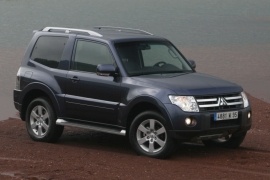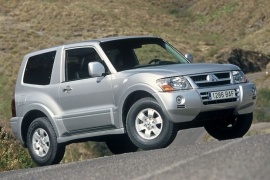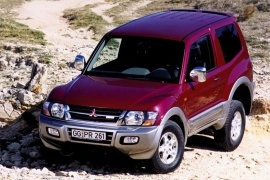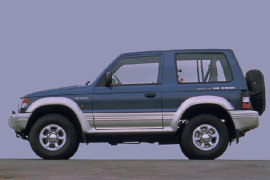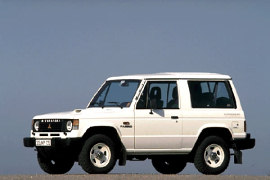MITSUBISHI Pajero 3 Doors Models/Series Timeline, Specifications & Photos
First production year: 1982
Engines: Diesel, Gasoline
Body style: SUV (Sports Utility Vehicle)
The fourth generation of the Pajero/Montero/Shogun broke its chains and stormed the Mitsubishi Motors booth at the 2006 Paris Motor Show.
Depending on the market, the biggest Mitsubishi off-road-er wore the Montero/Pajero/Shogun name. While it wasn't a revolution over its predecessor, it was a clear evolution that brought the car closer to its customers. Its only drawback on the European market was it's over three-liter engines led to higher taxes, leading to slow sales.
The flared wheel arches and the sloped roofline were unusual for a proper off-road vehicle. Its flared wheel-arches created a muscular appearance for the Japanese off-road vehicle. In three-door shape, the rear side windows featured an ascending lower margin between the B- and the C-pillars. Like its predecessors, the Pajero's fourth-generation kept its spare wheel on the rear, side-hinged door.
Inside, the Pajero featured a newly designed dashboard with a big instrument cluster. The center stack hosted the infotainment unit and an additional LCD for the onboard computer. At the front, Mitsubishi offered enough room for two occupants, but there was little room in the back, even for two passengers.
The technical platform was the one that brought the Pajero under spotlights. It was the only 4x4 vehicle in the world that featured a 4x4 on-demand system which could have been driven as an all-wheel-drive vehicle since it was fitted with three differentials. The central and the rear one could have been locked for better traction. For the engine bay, the manufacturer installed either a 3.2-liter turbocharged diesel or 3.8-liter gasoline. Both versions were mated as standard with a 5-speed manual, while a 5-speed automatic was available as an option.
MITSUBISHI Pajero/Montero/Shogun 3 doors 3.8L V6 5AT (250 HP)
Mitsubishi tried to revive its Pajero/Montero/Shogun lineup in 2003 with a mild facelift for both versions, with three and five doors.
Unlike most other off-road vehicles on the market, Mitsubishi's off-road flagship featured an integrated-chassis construction that lowered the car's weight, but not too much. The refreshed lineup enhanced both the look and the technical side. But Mitsubishi didn't decrease the engine's size, and that was costly for them. In Europe, everything that passes the 3.0-liter displacement was heavily taxed, and the Pajero featured only larger than those units, either gasoline or turbo-diesel.
On the outside, the Japanese carmaker reshaped the front bumper. It ditched the squared fog lamps and introduced a set of smaller round ones under the headlights. Moreover, it now featured body-colored bumpers and side protection moldings, which greatly improved the overall car's look. The Pajero/Montero/Shogun sported a pop-out window for the rear passengers and a shorter wheelbase in the three-door version.
Inside, the carmaker improved the cabin and included a restyled dashboard design that featured wood-trims on the center stack and on the steering wheel. Mitsubishi offered an option for leather seats, while the base version featured cloth upholstery.
The biggest changes were made under the hood, where the carmaker installed the same option for a 3.2-liter turbo-diesel or a 3.5-liter V-6. They were both paired to a five-speed automatic gearbox with manual mode. Like its five-door sibling, the Pajero/Montero/Shogun three-doors featured the Super-Select traction system, which allowed the driver to select rear-wheel-drive, all-wheel-drive with three differentials, and in a low-range mode for hard off-road.
MITSUBISHI Pajero/Montero/Shogun SWB 3.5L V6 GDI 5AT AWD (203 HP)
The third generation of the Pajero/Montero/Shogun brought the biggest change in the model's history since it changed the car from body-on-frame construction to unibody.
Mitsubishi took this decision since it noticed that most of its customers were spending most of their time with the vehicles on paved roads. Some of them never saw real off-road action during their existence. But the Pajer/Montero/Shogun was already known for its abilities, and the carmaker didn't want to lose those advantages. So, it offered the car with all the equipment needed for a hard-core off-road vehicle but installed them on a unibody construction.
While the five-door version was more suitable for families and long journeys, the three-door aimed at different customers. Not only that it was more appropriate for city usage, but thanks to its shorter wheelbase could handle some obstacles way easier. Last but not least, it was also cheaper. Moreover, the rounded shapes of the exterior induced the idea of a more civilized vehicle. It was, indeed, but without losing its main advantages.
Inside, there was enough room for the front passengers, but the rear ones had to struggle a little to sit tight on the bench. The limited legroom couldn't be compensated enough with the increased headroom area. But those who chose to get this short version usually didn't need the rear seats at all.
Depending on the market, the Montero featured a fuel-efficient range of diesel engines or a V-6 gasoline unit.
MITSUBISHI Pajero/Montero/Shogun SWB 3.5L GDI V6 5MT AWD (203 HP)
The second generation of the Pajero appeared on the market in 1991, and Mitsubishi offered it with different names, depending on the market, in three- or five-door versions.
Mitsubishi offered the three-door version for those who needed more off-road capabilities and less room in the back. While the vehicle was still built on top of a chassis, it featured other advanced technologies aimed to take the crown from Toyota's Land Cruiser. In addition, it already had to compete against other European carmakers, such as Land Rover.
The 1992 Pajero featured a flat front fascia with big squared headlights, corner-mounted turn signals, and parking lights, losing the round headlights of its predecessor. Its slightly tilted grille sported three horizontal slats and was adorned with chromed accents depending on the trim level. From its profile, the short-wheelbase version of the Pajero provided access to the cabin via a pair of doors. Behind the thick B-pillar, which also served as roll-over protection, the carmaker added a set of windows with a sliding opening system.
Inside, depending on the trim level, it featured either a cloth or a leather-clad interior. Its angular-shaped dashboard sported an instrument panel in front of the driver and a second one above the center stack. While the former showed the usual information regarding speed, revs, and engine status, the latter showed the car's pitch and roll angle, a compass, and an altimeter. In the back, there was limited room for up to three passengers and a small trunk. In fact, the trunk area was so small that the carmaker had to install the spare wheel on a side-hinged cradle behind the tailgate.
Under the hood, Mitsubishi installed a choice of gasoline or turbo-diesel engines. A significant upgrade was the Super Select transmission, which allowed the driver to drive the car with rear-wheel drive, or all-wheel-drive with three differentials and featured a standard center differential lock. A two-speed transfer case was also standard on all Pajero models.
That was the beginning of a successful vehicle that raised the Mitsubishi's flag twelve times in the most challenging race from those times, the Paris-Dakar Rally Raid.
Its rugged, simple appearance had a charming look, and it sold like hot cookies in the middle of the winter. The Japanese carmaker didn't see that success coming, and it was overwhelmed by orders from all the markets where it introduced the car, with different names such as Pajero/Montero or Shogun.
It might have a minimalist design on the market. That simple design came with low production costs. Despite its short length, it offered five seats inside. The three-door version featured a side-hinged rear tailgate. The wrapped-around metallic bumper protected the small, squared, and corner-mounted taillights.
Inside, the minimalist design continued on the dashboard with a flat panel and a grab-handle on the passenger side. The instrument panel offered two dials and two gauges, each in an individual cluster. Even though the center stack was a new interior item for cars, the Pajero/Montero featured one for the ventilation unit and the stereo. The carmaker offered a clinometer and two additional gauges for oil pressure and ammeter on a separate cluster over the center stack as an option. The car provided good interior room for the front passengers but limited for the rear ones. Despite its almost flat floor in the rear, the car's width was too small to provide enough shoulder and hip-room. As for the trunk, it was big enough for a briefcase.
The body-on-frame construction made the Pajero a trustworthy partner in harsh off-road situations. Under the hood, Mitsubishi installed diesel and gasoline engines depending on the market. All of them sent the power to a 4WD system with a low-range transfer box. At the front, the car featured independent suspension, while in the back, Mitsubishi installed a live axle.
